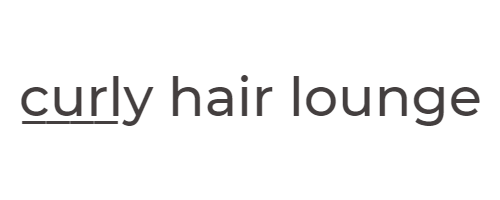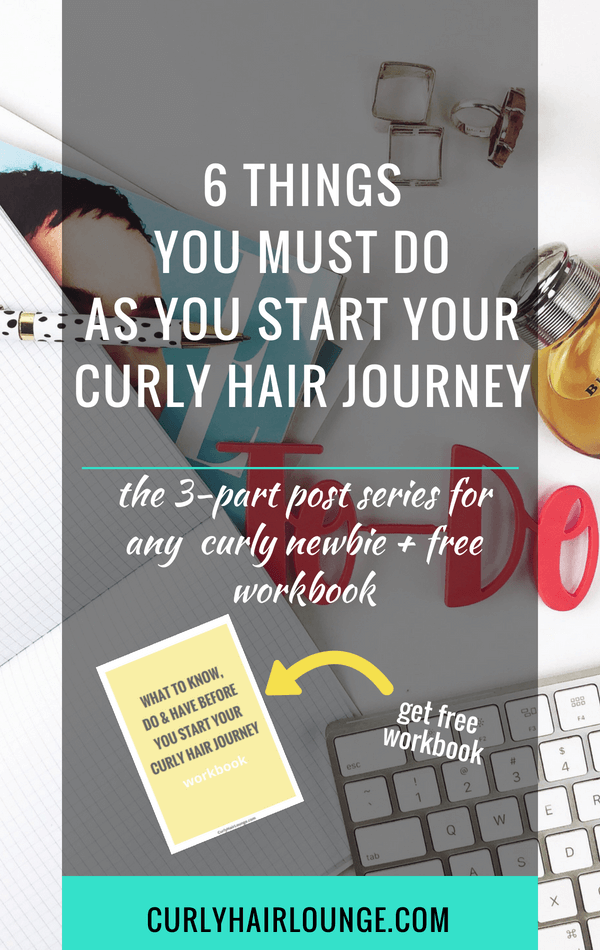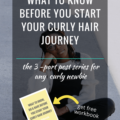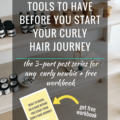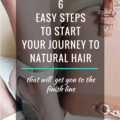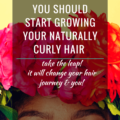Hey, there! Glad you made it to the last post in my 3-post series where, for the last three weeks, I have been sharing the steps you need to take before you start your natural hair journey without having to ‘blindly’ find your way through as you go. It’s kinda’ like a theme party we’ve been having here every week and if you’ve been joining in you’re a champ!! If you missed the fun, there’s no need to shed a tear, you can catch up and read the previous posts here:
- What To Know Before You Start Your Curly Hair Journey
- Hair Products And Tools To Have Before You Start Your Curly Hair Journey
While in the lasts posts I talked about what you need to Know and Have, in this post I will be talking about what you need to Do. My aim is that by the end of this series, which ends today, you would have a roadmap to confidently take your first steps as curly hair newbie. 😉
So, if you’ve caught up on your reading and you’re ready to go, let’s make a move on it. Oh… don’t forget to download the 9-page workbook that comes with this post series. It will help you draw up an initial plan of your hair journey.
6 Things To Do As You Start Your
Curly Hair Journey
#1| Stop Any Chemical Treatments
This may be an obvious thing to say, but I like to be clear just in case you have any doubts. You should stop relaxing, bleaching, colouring or doing Keratin/straightening treatments now that you made up your mind that you want to let your curly hair grow naturally.
Does, this mean you can’t play with colour on your hair anymore? No, it doesn’t mean that. But, since you’re starting a new journey where, most probably, you don’t even remember or have seen your natural hair in many years. It’s important you get to know it first so that you can recognise its normal/natural condition and when something is not right. So, only think about dyeing or bleaching further down in your journey when you’re more acquainted with your curly hair and more knowledgeable about it, or get a really good stylist.
As for relaxing and keratin treatments, it is my personal experience that they alter the hair structure straightening it and they completely defeat the point of being a curly girl. If you’re still having some insecurities about going natural here is a myth-busting post and here’s another one just so you can be clear.
#2| No Direct Heat
If you thought that flat ironing or using direct heat on your tresses would make going natural easier, you’re not the only one. Many newbies actually do it. However, curly hair is more vulnerable to damage than Caucasian or Asian hair and for that reason straightening your hair frequently leads to heat damage (loss of elasticity, breakage).
This is bad news if you really want your curly tresses back healthy and strong, but it can be even more dramatic if you’re transitioning since your relaxed hair is weaker than your natural hair and severe hair breakage can happen at the line of demarcation (the place where both hair textures meet).
Can you still use heat? Yes, but I would advise you to stay away from direct heat in the early stages of your journey. Just as with using chemical treatments I recommend you get to know your hair first, let it’s health improve and when you do use heat do it sporadically, with proper protection and correctly (here is are some tips about flat ironing). For transitioners, the best time is after your big chop, when you cut the relaxed ends for good to avoid breakage, but this is just my opinion.
If you believe that as a newbie straightening your hair makes it easier to manipulate, care and style your natural hair while you get used to a new hair texture than you can read this post. It has a few suggestions on how you straighten your hair without using heat. For now, use heat for your deep treatments.
#3| Get a Trim
I lot of people don’t trim their hair regularly because of a bad experience with a hair stylist or because they believe they don’t need it, they only need it once a year or they can do it whenever they feel they need to. The problem with this is that the ends are the oldest part of our hair, which means they are the weakest and more porous part and they are more vulnerable to hair damage. Not trimming means you can easily start to experience knots, split ends, flyaways, increased porosity and hair breakage.
A good trim or haircut, allows your hair to breathe new life and strengthens it. To start on the right foot and to avoid dealing with massive hair breakage (a common issue for transitioners) give your hair a good cut. After this, trim regularly to maintain your hair’s health and gradually get rid of relaxed hair. How often you do this will depend on your hair care practices and hair condition, it can be every 6, 8 or even twelve weeks.
For a few tips on how to identify hair breakage and shedding, read this post. It can help you understand if you need a trim or if it’s a normal thing in your hair’s life cycle.
#4| Deep Condition Regularly
If deep conditioning was never a regular practice for you then I urge you to start making it so. Deep conditioning provides intense moisture, repair and nutrition that has long-term effects and protect your hair against hair damage and can improve its health.
I see it as a secret weapon that helps you offset hair damage while you’re taking your first steps and learning to make sense of everything in the curly hair world. Moreover, it can also be the ‘magic dust’ (though there’s no magic here) that finally delivers your dreams of healthy, moisturised curly hair (if you also have the right hair care practices and products).
My belief in this is so strong that I even wrote a whole guide – The Curly Guide to Deep Conditioning – sharing everything I know about it and how you can do it effectively and correctly. You can know more about it here.
#5| Do Wash Your Hair
Most people fall into the mistake of thinking that product application prevents the hair from getting dry. However, in reality, the only way to avoid hair dryness if to get water into your hair to hydrate it… not using moisturisers. These are effective in creating a barrier to prevent and delay quick water release from inside the hair.
The best way to keep your hair moisturised is to wash it then you can use your moisturiser. However, a lot of people only wash their hair once or twice a month. If you consider that hair loses moisture anywhere between 3 to 10 days depending on climate, products used and even your hairstyle (if there’s more surface available/free hair will dry faster) then you can understand how so many people are complaining of dry hair or have issues with hair breakage.
So my make sure you don’t go without washing your hair for longer than 10 days, and that goes for people in protective hairstyles too, though you need to adjust your wash routine to keep your protective style from looking unkempt.
#6| Detangle Thoroughly
Does this sound like a weird advice or tip to give?! Yes, it may be, but way too many people are not detangling their hair properly because they only stick to finger detangling. Finger detangling works well in the beginning stages of your transitioning hair journey when most of the hair is relaxed and easy to detangle.
You’ll find out, as I did when I finally cut my relaxed hair, that you need something more to really get in there and not miss a tangle or knot. Curly hair is more wiry, thick and hard to detangle. Though finger detangling allows a better perception and feel of the hair initially, as your curly hair grows it’s easy to miss tangled sections especially near the scalp. So don’t be afraid to introduce a wide tooth comb or brush alongside your hands and really get in there to avoid major knots and tangles.
Aaand… That’s a wrap!! These are the tips I have to give you if you’re about to start your hair journey.
Could more be said? Yes, definitely! But I feel these are the main points to retain, the most important ones, those where people make the most mistakes. Yes, I could talk about microfiber towels, nighttime routine, sectioning hair and such… but some of this I already covered in some way or another (directly or through links) in the previous posts in this series so go read it! For more general tips read 12 Tips On How To Transition To Natural Hair the rest you’ll learn with time. 😉
Thank you for coming along with me in this post series. It has been fun thinking and writing about what I’d do differently and what can help you as you start your journey! 🙂 Now, because there is a lot of information to digest in this post series I want you to go read it all over again and complete the free workbook that accompanies it. You can download it from inside my Library of Resources which you can have access here. It will help you plan things and set your initial route. 😉
If you enjoyed this post series, don’t forget to share and to tag Curly Hair Lounge (@curlyhairlounge). I’d love to say, “Hi!”. Click below to tweet a pre-written tweet, but feel free to change it.

Now it’s your turn! Have any questions about starting a starting a curly hair journey? Let me know in the comments.
